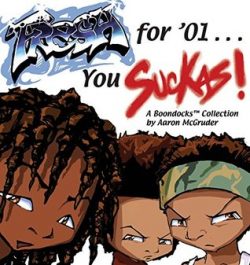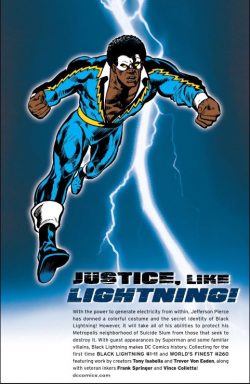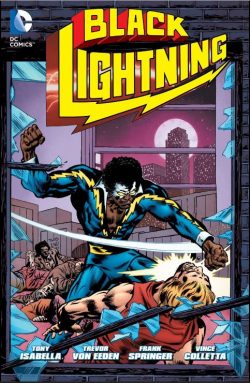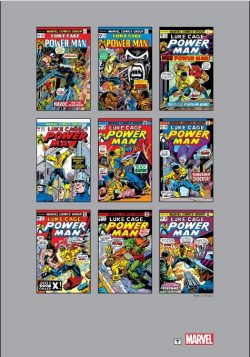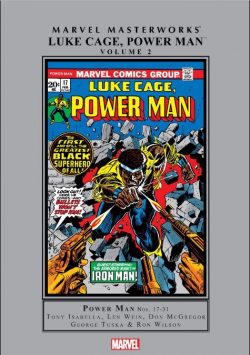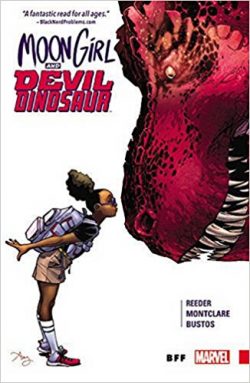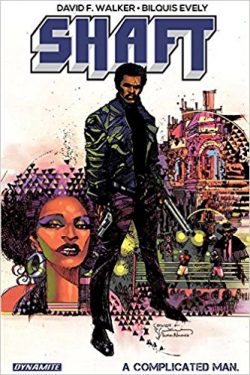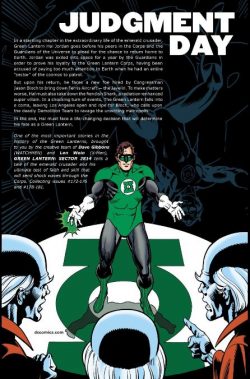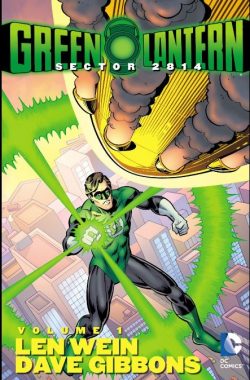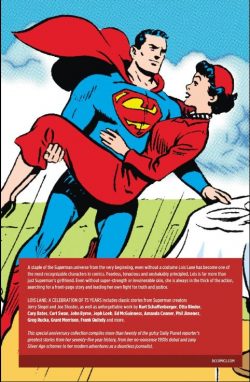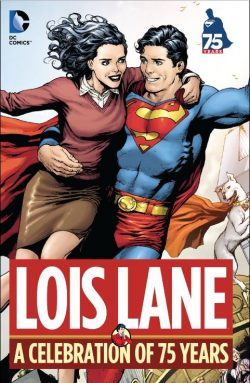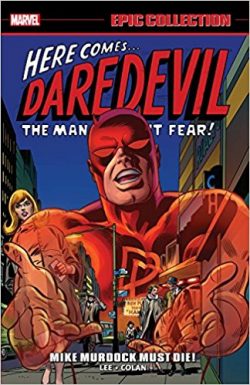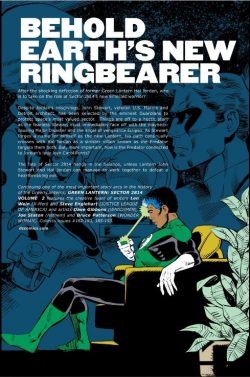
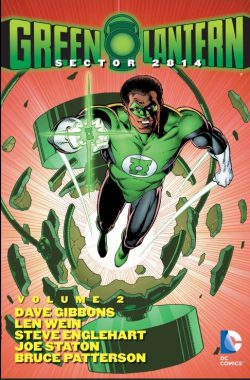
By Len Wein, Paul Kupperberg, Steven Englehart, Dave Gibbons, Bill Willingham, Joe Staton, Bruce Patterson, Mark Farmer, Rich Rankin & various (DC Comics)
ISBN: 978-1-4012-4078-3
When mortally wounded alien cop Abin Sur crashed on Earth he commanded his power ring – a device which could materialise thoughts – to seek out a replacement officer, honest and without fear. Scanning the planet, it selected brash young test pilot Hal Jordan in nearby Coast City, California and brought him to the crash-site. The dying alien bequeathed his ring, the lantern-shaped Battery of Power and his professional vocation to the astonished Earthman.
Over many traumatic years, Jordan grew into one of the greatest members of a serried band of law-enforcers. The Green Lantern Corps protected the cosmos from evil and disaster for billions of years, policing vast numbers of sentient beings under the severe but benevolent auspices of immortal super-beings who consider themselves the Guardians of the Universe.
These undying patrons of Order were one of the first races to evolve and dwelt in sublime, emotionless security and tranquillity on the world of Oa at the very centre of creation.
Green Lanterns are chosen for their capacity to overcome fear and are equipped with a ring that creates solid constructs out of emerald light. The miracle weapon is fuelled by the strength of the user’s willpower, making it one of the mightiest tools imaginable.
For eons, a single individual from each of the 3600 sectors of known space was selected to patrol his, her or its own beat, but being cautious and meticulous masters, the Guardians laid contingency plans as appointing designated reserve officers.
Jordan’s substitute was a nice quiet (white) PE teacher named Guy Gardner, but when he was critically injured the Oans’ fallback option was a little worrying to staid, by-the-book Hal.
In Green Lantern/Green Arrow #87 (December 1971/January 1972) ‘Beware My Power!’ introduced a bold new character to the DCU. John Stewart was an unemployed architect and full-time radical activist: an angry black man always spoiling for a fight and prepared to take guff from no-one.
Jordan was convinced the Guardians had grievously erred when selecting rash, impetuous Stewart as Sector 2814’s official Green Lantern stand-in, but after seeing how his proposed pinch-hitter handled a white supremacist US presidential candidate trying to foment a race war, the Emerald Gladiator was delighted to change his tune…
As time progressed Stewart popped up occasionally even as the Guardians’ motives and ineffability increasingly came into question by many of their once-devoted operatives and peacekeepers. All too frequently, the grunts began seeing their formerly infallible little blue gods exposed as venal, ruthless, doctrinaire and even capricious…
As his repute grew, headstrong Hal enjoyed an extremely tempestuous relationship with his bosses which eventually resulted in them accusing him of neglecting his space sector – 2814 – to concentrate on Earth’s problems and criminals.
When he couldn’t reconcile his love for Carol Ferris and duty to the Corps, Hal Jordan quit…
This second stellar Fight’s ‘n’ Tights trade paperback compilation – also available in eBook editions – gathers Green Lantern #182-183 and 185-193, covering November 1984 through October 1985: a period of radical change and increasing cosmic calamity as the DCU counted inexorably down to a reality-altering Crisis on Infinite Earths…
Len Wein, Dave Gibbons & Mark Farmer continued their groundbreaking reshaping of the legend as ‘It’s a Dirty Job, But…!’ saw the now merely mortal Jordan second-guessing his decision as he revisits Abin Sur’s remote resting place. Meanwhile, across the universe, the Guardians moved swiftly, promoting Stewart to the prime position in his sector. At the time the architect was working on rebuilding the shattered Ferris Aircraft complex and had no idea that Hal Jordan was the alter ego of his abruptly “retired†predecessor, nor that GL Jordan’s old enemy Major Disaster was back and looking for a fight…
Further complicating matters, Dr. Bruce Gordon – currently building a solar engine for Ferris – was being stalked and harassed by his own inner demon made manifest. Before Green Lantern had helped cure him, Gordon was the unwilling host of a demonic hate-filled energy spirit called Eclipso. Now the monster was apparently back and trying to steal the almost-completed solar engine…
When Major Disaster furiously threatens to destroy a massive hydroelectric dam and flood the entire state, the Emerald Gladiator he stridently demands a rematch with is not the one who turns up…
Refusing to accept any substitute the madman triggers a ‘Day of Disaster’ and learns to his sorrow that the masked black man is every inch as competent and formidable as his despised archfoe.
Green Lantern #184 reprinted the origin of Guy Gardner from #59 in 1968 and has been omitted from this collection but Wein & Gibbons (inking himself again) return for #185 as ‘In Blackest Day…!’ sees the new ringbearer for Sector 2814 fully acclimate to his responsibilities. An overnight celebrity and media sensation, Stewart is courted by TV reporter Tawny Young but earns her enmity after refusing to divulge the circumstances of his origin and promotion.
On a more mundane level, Hal still frets about his decision and loss of power, even as his romance with Carol hits a new snag. Unknown to either of them she has acquired a super-powered stalker determined to protect her from anything he perceives as a threat…
With Eclipso still secretly badgering Gordon, Hal prepares to test-fly the prototype Ferris solar jet, but is ambushed by his old pal and mentor Rich Davis.
The medically-disqualified pilot wants one last flight of glory and takes Hal’s place, only to become a hostage when Eclipso snatches the jet out of the sky in his fantastic landscape-rending moon satellite…
‘In Brightest Night…!’ Wein & Gibbons (with plotting input from Paul Kupperberg) sees the new GL rush to the rescue as Hal can only look on helplessly, but when Carol’s mystery suitor The Predator also boars the moon globe the situation flares beyond control and results in victory at a terrible price…
Kupperberg, Bill Willingham & Rich Rankin then provide a rapid fill-in for #187 (April 1985) as ‘A Day in His Life…’ finds Carol confronted by the Predator who declares his amorous intentions by beating up her current boyfriend Hal even as John Stewart tackles his first space catastrophe and narrowly escapes destroying the malfunctioning space shuttle he was trying to save…
Thankfully, the all-wise Guardians have anticipated teething troubles and despatched veteran GL Katma Tui be his training officer…
The next issue heralded a changing of the guard as writer Steve Englehart and illustrators Joe Staton & Bruce Patterson signed on with ‘Decent Exposure’ wherein Tawny Young outs John Stewart on national TV, and he – after some early frustration – decides “so what?â€
With the Predator proving to be far more than a mere abusive, controlling maniac, Hal swears revenge even as European ultra-nationalist Sonar returns to destroy the new Green Lantern to prove the superiority of his postage -stamp principality Modora…
After Stewart proves his worth with a uniquely elegant solution to the villain’s sound weapons, ‘Echoes!’ sees Sonar bounce back: escaping from custody with enhanced allies Blindside and Throttle, despite the assistance of Katma Tui. Hal and Carol’s search for Predator lead them to a much-delayed visit with practically-braindead shut-in Guy Gardner, inadvertently starting those long-dormant cogs clicking again…
After Stewart at last apprehends his fugitives a new crisis has struck. ‘Time Out of Mind!’ starts with Tawny Young re-entering the picture, touting years-old video-tape interviews she carried out with Green Arrow, Black Canary, the previous GL, Carol Ferris and Stewart himself. Disturbingly, nobody on Earth remembers the meetings and if the journalist hadn’t been raiding the archives never would…
As she shows the tapes to the astounded superheroes, Predator nonchalantly ambles in to steal the tapes and is stunned to realise that the gimmick he’s used to make everyone unable to see him doesn’t work on alien Katma…
Back-up tale ‘Mind Out of Time!’ then focuses on Hal’s hunt for Predator and furious confrontation in a theatre in front of a bizarre alien musical organ. That preliminary bout becomes the main event in GL #191 as ‘Macho!’ finds John and Katma off-earth and working with Dalor of Timron – Green Lantern of neighbouring Sector 2813 – whilst Jordan’s final confrontation with Predator reveals an uncanny, impossible connection to Carol which revives her own darkest secret…
Green Lantern #192 sees the separate storylines converging in ‘First Star I See Tonight!’ as the space-borne Emerald officers tackle the immortal amazon warriors of Zamaron even as on Earth, Carol reverts to sometime-alter ego Star Sapphire: now finally purged of the annoying, pitiful humanity that held her back from operating as the dominating tyrant and chosen queen of those self-same Zamarons…
Utterly dominating powerless Hal, she reveals the decades long machinations that have led to this moment of terrible triumph before teleporting home where three furious Green Lanterns are waiting…
This volume concludes with the return of another Hal villain in ‘Dead Ringer’, but where Jordan defeated the tragic alien Replikon through brute force and guile, Stewart proves his worth through innovation and compassion: building a solution which makes friend out of foe and rights a grave cosmic injustice…
At the time, many fans and critics felt that the substitution of Hal Jordan with John Stewart was little more than a PC stunt, but time and the quality of the stories has proved the decision to be brilliant one. It certainly offered a cruelly under-served portion of the readership another solid role model but as time progressed and the different personalities and approaches coalesced, the move led to an expansion and re-evaluation the nature of being a DC hero.
And the best was still to come…
© 1984, 1985, 2013 DC Comics. All Rights Reserved.

